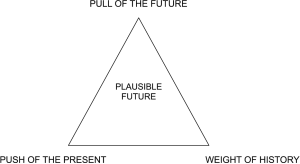The process of creating a future is thought-provoking and complex, and the most successful scenarios are ones that are plausible and makes us think. Fry stated that the “Fact that the future can never be viewed or fully predicted does no negate our responsibility to identify possibilities that beg precautionary action”, (Fry, 2009, p145-155), although we can predict the future according to our present, it is even better to design from “the future to the present” in order to get the best outcome.
We think about the future to set goals and set ourselves on the right path, especially with the prowess and risk of nuclear power, human being as a species has to think about how to proceed. Creating a future transcends the simple objective of making something futuristic, and Dr Chris Riedy’s lecture this week provided the simplest explanation of this idea:
To present a successful future scenario, first we must establish the future we want, and pave our way backwards with the help of present ideals and historical context.
Another source we looked at this week is the advertisement campaign for the movie “Prometheus”, in tandem with the movie of the same title, it painted a vivid view of the future, or at least, a glimpse of what human beings would be achieving in the future. It talked of galaxy exploration as the norms, diseases eradicated and better economy. The future it paints is one that we currently desire, but what made it stand out against other science fiction are the amount of details, not on the future, but on how its been achieved. Back-casting requires us to cling to particular norms to make us feel comfortable in the scenario, presenting elements of familiarity to make us feel more comfortable. The Weyland Industry campaign achieved this by providing information on issues that are concern to us now, medicine, employment and finance.
The Limits to Growth report (revisited by the Club of Rome Campaign) questions the destination that the world is heading. The report does not offer predictions, rather it portrayed scenarios based on trends and different policy decisions. By visiting possible (negative) futures and working backwards, we should be able to break out of our “business-as-usual” attitude and make real change instead of basing them on “short-terminism, resulting in a slow societal response to challenges.” (Randers, Jorgen 2012).
We have moved from the simple idea of a future, and to the more complex notion of a plausible future. Through the use of STEEP (Society, Technology, Economy, Environment, Politics), we will be able to analyse further into the scenario we have creative – having a future is not enough, it must be plausible, and that we would want to go towards it. Future design helps us visualise, not a fixed future, but one that is preferred or achievable, and that is what we strive for.
Reference
Fry, T. 2009, ‘Design futuring: sustainability, ethics and new practive’, Oxford, pp. 145-55.
Randers, J. 2012, The Count-up to 2051: An Overarching framework for Action, .
Riedy, C. 2012, The Plausible Futures Triangle, .
Scott, R. Weyland Corporation (Online Viral Marketing campaign for ‘Prometheus’ Feature Film), <http://www.weylandindustries.com/>.
